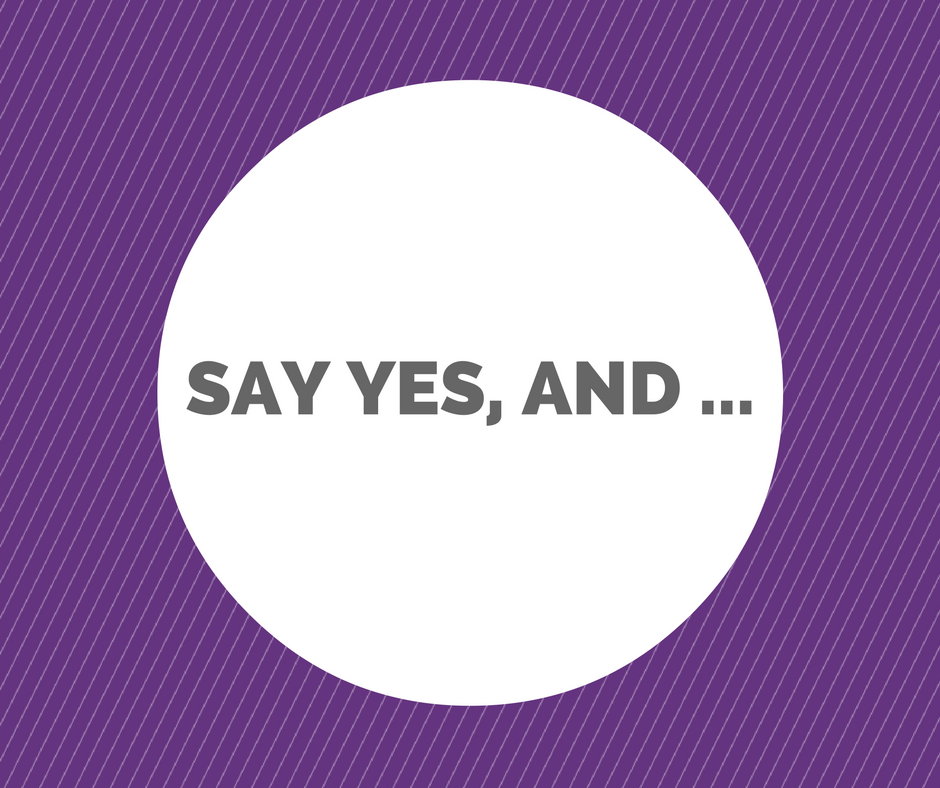I used to think that in order to do improv you had to be funny.
By funny, I meant witty. I meant the kind of person who tosses off one-liners on Twitter that make people fall off their chairs laughing.
Then, I studied improv. I was shocked to learn that the wittiest actors had a more difficult time learning to improvise than most. Why? Because the foundational skill of improv is listening. Once they’ve truly listened, improvisers are taught to say, “Yes, and …”
Time after time, I watched the funniest actors either say, “No, but listen to my hilarious idea,” or struggle to speak at all, too caught up with their own plans to be present in the scene. When we say “yes, and ….” we have immediate momentum. Many of us have heard this phrase so often that it’s easy to miss its subtle power. But for a moment, stop to consider a challenging situation in your life.
What if rather than struggling along, you could have immediate momentum?
Let’s put “yes, and …” into context.
Say you’ve been wanting to organize your garage for quite some time. In fact, it’s become such a jungle you think small creatures may be hiding out there. What would happen if the next time you think (or your spouse says) “You know, we really should clean the garage,” you said, “You’re right. I’ll take a few minutes right now to straighten the shoes.” Once you’re out there, straightening the shoes, how likely is it that you’ll think of three or four other small tasks that you can do without too much effort? Each task moves you closer to your goal: a clean garage. Presto! Instant momentum. That’s what you normally say and do, right? Of course not. What you do is think something along the lines of “I know, but it’s such a mess and I have no idea where to start, and what difference will it make anyway? It will just get messy all over again.”
“Yes, but …” or worse, “No” stop us in our tracks. Every time we say these things, we might as well be pulling out a shovel and digging ourselves deeper into a trench. We are literally becoming entrenched.
“Yes, and …” is deceptively simple. But, mastering this phrase can transform your life.
Say Yes
The next time you’re with your daughter or niece and she tells you, “There’s a dragon in the living room,” try saying, “Seriously? Let’s go sneak up on it!”
The next time someone invites you to try something new and you’re not sure if you’ll fall flat on your face, try saying, “I’d love to try. Can you show me how?”
Should We Always Say Yes?
Sometimes we need to establish boundaries. We can’t say yes to every coffee invitation, every work project, or every cupcake offered. On stage, sometimes actors throw out a wild, impossible suggestion. “Let’s use our wings and fly!” In these cases, both actors have to think, “How might I say yes? How might I move the scene forward?”
What we’re aiming to avoid is the knee-jerk no. It’s the no that leaps from our lips the minute we face the unknown or unexpected. The knee-jerk no is powerful, and much more present in our lives than we realize. What would happen if for one day, you banned the word no? What if every time you were about to say, “no,” you asked yourself, “How might I say yes?” If nothing else, you might have to say, “Maybe. I’ll get back to you tomorrow.” But for one day, what if your knee-jerk answer was yes?
Add And
Surprisingly, as hard as “yes” can be, the part that’s even more difficult for many actors is “and.” One actor says, “Watch out! It’s an alligator.” The second actor jumps back, turns to the first actor and asks, “What do we do?” Now the first actor has all the responsibility to continue building the scene, while the other actor passively comes along for the ride. What if the second actor said, “I have a lasso!” Suddenly, the scene has become a lot more interesting, and it’s probably headed in a direction the first actor didn’t expect. Most of the time, diversity of thought makes for more layered and unexpected ideas.
This kind of situation happens in real life, too. A coworker or boss tells us, “We don’t have enough people attending our event to break even with our budget,” and we reply, “What can I do to help?” What if, instead, we said, “Do you have a minute to brainstorm? One idea might be …” “Yes, and…” is the equivalent of reaching out to offer a hand when someone is struggling to carry an awkward box. The point is not to make every problem our problem, or to tell other people “You know what you should do …” but rather to notice opportunities to not only offer support, but to collaboratively transform the moment into a possibility neither person expected.
My question to you is—What would happen if for one day, you intentionally said “Yes, and …” to the world around you?
Have fun experimenting, and let me know how it goes!


